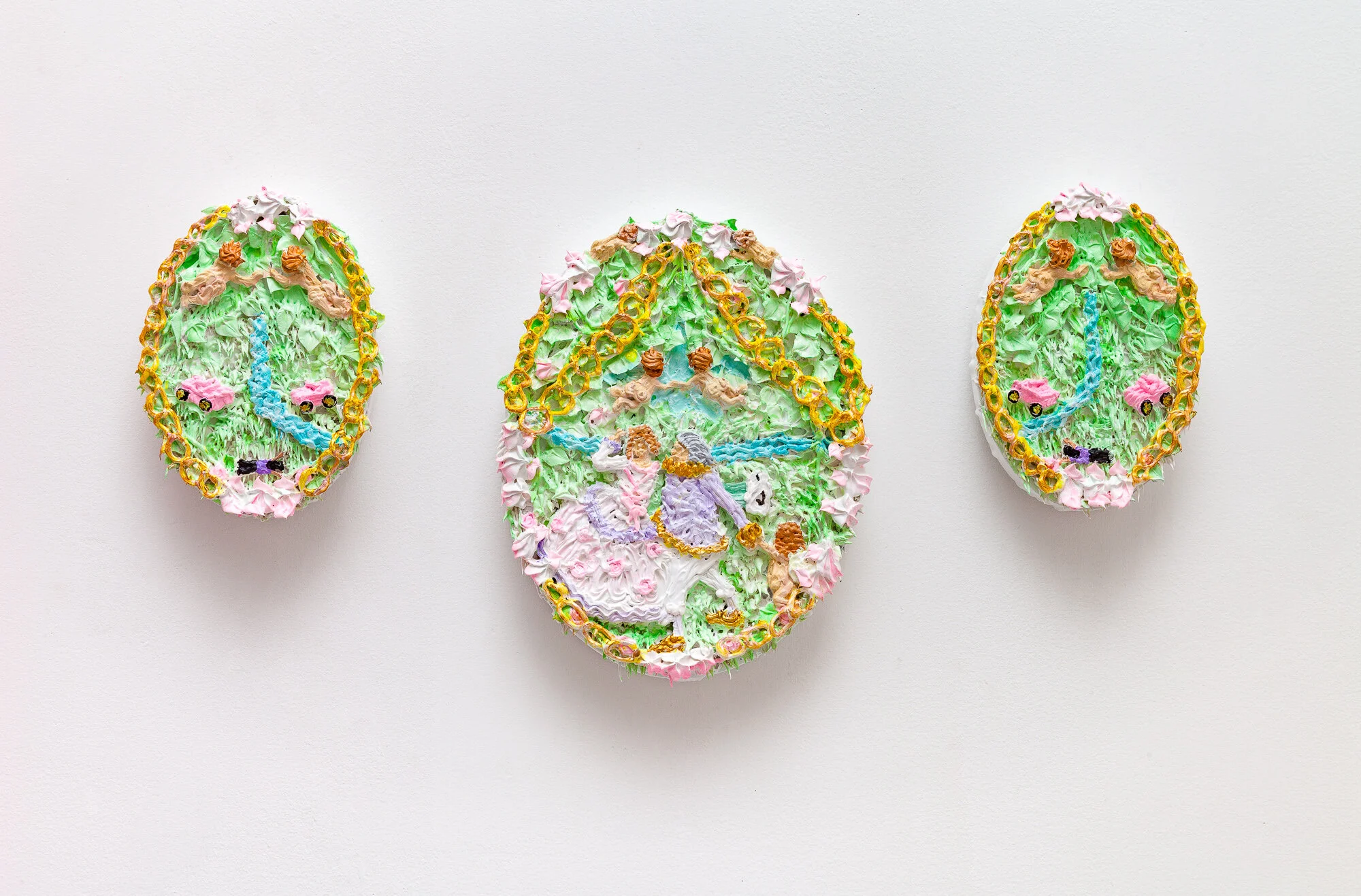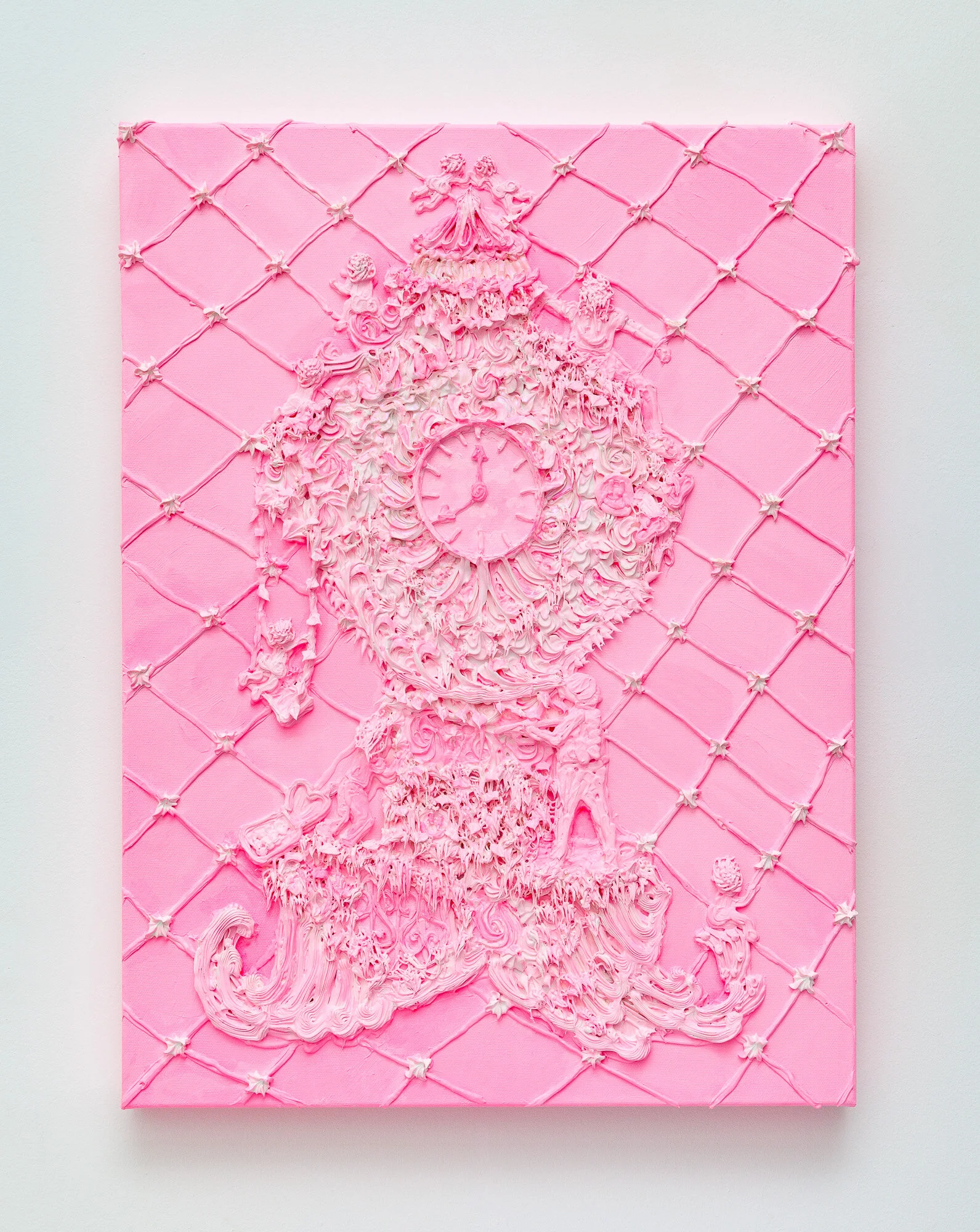A Part of US, 2019, installation, 40’ x 10’ x 10’ GEARY Contemporary, New York, NY.
Through the Gate, 2019, acrylic piped on canvas, 48”x 60”
Yvette Mayorga, A Part of US, 2019, Installation Image, Geary
American Urn, (After Madame Victoire vases at Château de Versailles,) 2019, acrylic piped on canvas, 48”x 60”
Two Lovers (After Rocco Porcelain Urn 19th c.), 2019, acrylic piping on canvas, 5” x 7”, 8” x 10,” 5” x 7”
American Urn 3 (After Rocco Porcelain Urn 19th c.), 2019, acrylic piping on canvas, 18” x 24”
A Part of US, 2019, installation, 40’ x 10’ x 10’
GEARY Contemporary, New York, NY.
Excerpt: Of Cakes and Rococo Fantasies; The edicts of Mayorga’s Pasteles
by Emmanuel Ortega
At first impression, the canvases of Yvette Mayorga radiate an innocence that allows for further unwary examination. The piped brushstrokes with pastel(1) colors and rich surfaces recall the vacuous formalism that reigned supreme in Marie Antoinette’s Versailles court. However, her overwhelmingly sweet surfaces erase the imperial cogitative “let them eat cake,” and instead, challenge this rhetoric through a different narrative. Upon closer inspections her images appear to melt into unpolished sugary scenes that problematize a superficial encounter with her art as solely an extension to her Latinx heritage, femininity, legal status, and expectations of childhood amidst all these markers of identity. It is at the intersection of these expectations where these images come to life, not as 18th century French fantasies, but as windows into contemporary reality.
Kirsten Pai Buick in “No exit? Deborah Roberts and the Liberation of Black Childhood,” argues that children must be separated from the concept of “childhood” given that, “historically, the representation of childhood has been rooted in adult projection and fantasy…”(2) At present, the sentimentalization of Latinx children in concentration camps has turned them into torchbearers for the amendment of a broken U.S. immigrant system. It is through the constant flow of photographs in news outlets and social media where childhood ceases to perform its duty as innocence and begins to symbolize the weight of our justice system. Understanding how Latinx kids are the embodiment of “childhood of the Trump era” allows us to better comprehend Mayorga’s work.
At every turn, small green plastic soldiers and ICE agents frame saccharine rococo fantasies. Surfaces flooded with everything from Cheeto bags to Coca-Cola charm bracelets recall a seemingly innocent upbringing in the United States. Her references to systematic violence via toys of war and capitalist fetishes sediment the rupture between children and the expectations of childhood. For Latinx kids, the moral prospects always fluctuate in a liminal transitory stage between Latin American Catholic principles and U.S. capitalist morals. Mayorga understands the nuances of this liminal stage, and as a response, has created a body of work that subverts the sentimentality of all the identity markers that a life in this country has placed upon her.
The ethics of beholding los pasteles de Mayorga rest in the ways in which sentimentality is denied via her work; in her own words, “I'm interested in having the viewer think that they're going to experience something […] sensory or decadent, but then, through being attracted to the colors, to the smell, they discover that the work is about something else, something more profound, something darker.”(3) If one is not attentive, Mayorga’s work may unfold like a seductive ornate medusa, instead of a much necessary call to action. The formal lushness of rococo aesthetics is a tool for the artist to entice the viewer to scrutinize their complacency in these systems of oppression. Further, the luxuriant vases encapsulate an immigrant world in which good taste is rooted in replicas of French material culture. Her approach to such objects also exposes a reality in which the capitalist tendencies of buen gusto(4), which derive from 19th century Mexican culture, are intercepted by reminders of a failed American dream that many of us have to confront everyday. Mayorga’s piping is not constructed out of sugar, but deconstructs the politics of sugar; her toy soldiers are not made out of frosting, but are modeled out ICE-ing; and, in a similar gesture, we are meant to consume her pastel edicts as supposed to thinking that she is simply letting us eat cake.
(1) I am using the word pastel here as the Spanish word for cake
(2) For more information on the politics of Buen Gusto in Mexico please read the following compilation: Niell, Paul B., and Stacie G. Widdifield. 2013. Buen gusto and classicism in the visual cultures of Latin America, 1780-1910.
(3) Kirsten Pai Buick, “No exit? Deborah Roberts and the Liberation of Black Childhood,” inDeborah Roberts The Evolution of Mimi, ed., Brownlee, Andrea Barnwell, and Valerie Cassel Oliver Georgia Museum of Fine Art, University of Georgia for the Spellman College Museum of Fine Art, 2019.
(4) Cardoza, Kerry, “The American Dream in the Frosting of Yvette Mayorga.” Chicago Reader, April 25, 2018. October 10, 2019. https://www.chicagoreader.com/chicago/yvette-mayorga-american-dream-mexican-immigrant/Content?oid=46391835






